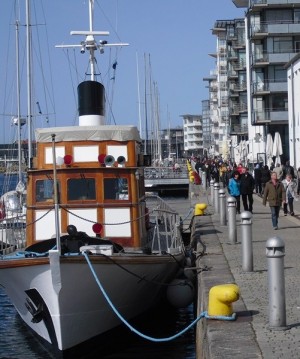The Red, And Blue, Of Seaside Helsingborg
The Ass was on the move — or rather, The Ass. He was a large, overly obnoxious Swedish man, and I loved him.
I was with my friend Martin at Olympia, and I had officially lost it. The early April weather was pleasant enough, but my blood was absolutely boiling thanks to the collective energy of around 17,000 supporters of the Helsingborgs IF (HIF) football club. We were seated amongst the Kӓrnan — the most devout of Helsingborg’s already rabid fans — and The Ass was leading us on, his booming voice so loud, he didn’t need a microphone to issue instructions. We hooted, hollered, sang, screamed, and swore for almost two hours, waving flags and gesturing wildly all in the name of sport. Things that should probably not be translated into English were uttered repeatedly, prompting me to decide that the first thing I would do when I returned to Vӓxjӧ that evening was go to church.
Though I found the spectacle to be somewhat less than life-threatening, some Swedes would disagree.
“You went where?” my mortified editor of a major Swedish news outlet asked me about a month later in a half-full Stockholm café. “Helsingborg can be quite strange, you know.”
While I generally find him to be an agreeable person, I found his statement to be decidedly less so. While it’s true, Helsingborg may have a fiercely independent streak brought about by a close proximity to Denmark and centuries of war, the modern port is a perfect blend of country charm and big city bustle. It’s not strange at all; it’s simply one of a kind.
The closest point in Sweden to Denmark, over a million passengers pass through Helsingborg per year on their way to or from the Danish cities of Helsingør and Copenhagen. Many of them see very little of the place itself, making it one of the relatively hidden gems of Nordic travel. Though smaller than nearby (and much-reviled, at least in the football world) Malmӧ, the city of roughly 100,000 is chock-full of cultural and historical attractions, boasting everything from jazzy waterside art galleries to stunning castle ruins perched up high.
Helsingborg’s position on the Øresund waterway lent itself to vital strategic importance during the many Swedish-Danish wars (the frequency of which makes the British and French empires appear as if they were soul mates), and it was battled over and battered down with depressing regularity. That history is best exemplified by the city’s medieval tower, Kӓrnan (Swedish for “The Core,” and the namesake of HIF’s supporters club). First built by the Danes to help control access to the Baltic Sea, Kärnan surrendered to Sweden along with the rest of Helsingborg as part of the Treaty of Roskilde in 1658. The fortress was retaken by Danish forces in 1676 during the Scanian War, and then returned to Swedish control in 1679 thanks to the Treaty of Lund. Fearing it was too vulnerable to another attack, King Charles XI had the fortress demolished, leaving only the core tower. Today, visitors may visit the brick-colored tower free of charge, enjoying superb vistas of the surrounding area below.
The history of the city itself may be a red one, but visitors today are likely to be left breathless by the vivacious blue encompassing the cozy harbor.
The first thing that struck me, though, was the weather. When Martin and I departed early in the morning from our home base of Vӓxjӧ in the deepest parts of Sweden’s sleepy southeast, traces of snow still mottled the ground like powdered sugar sprinkled atop pancakes. When we reached Helsingborg about three hours later, it was sunny and in the 60s Fahrenheit.
Two other things also struck me in quick succession: the smell, which contained a rich saltiness infinitely more pleasing than the stench brought about by the “world’s largest elephant garlic festival” that my hometown back in the U.S. (North Plains, Ore.) is known for, and the sea, of which I had never seen a more rich, more vibrant, azure shade.
Despite my obvious amazement, Martin seemed oblivious. Then again, as a Helsingborg native, he was used to it. The proper term for someone from such a place is “spoiled.”
Martin’s status as a local meant an inside track into what to see and do. Our primary purpose was to see the football match (as a HIF supporter, Martin had season tickets), but we had a few hours to kill before making our way to the stadium. A leisurely stroll past Helsingborgs rådhus (City Hall, which opened in 1897 and was declared a historic landmark in 1967), along the waterfront and up Kӓrnan’s cracked cobblestones (on top of which one can clearly see across the Øresund to Denmark without binoculars), left us in a precarious situation: famished, we needed food not only to refuel, but to get us through the marathon that lay ahead. Knowing this, we opted to indulge in that most time-honored pre-game meal for sports fans: fast food.
(Article continued on next page)

